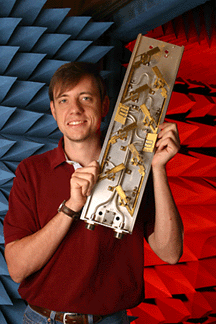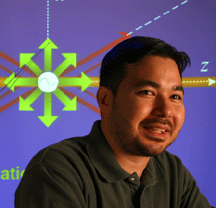Timothy Kennedy and William Langston, doctoral students in electrical engineering at the Cullen College of Engineering, were recognized at separate IEEE International Symposia this summer.
Kennedy was one of 15 finalists invited to present in the student paper competition at the 2003 IEEE International Symposium on Antennas and Propagation. His paper, entitled “Modification and Control of Currents on an Electrically Long Monopole Using Magnetic Bead Loading,” was chosen from among 135 entries from around the world.
Kennedy recently completed his master’s degree in Electrical Engineering. He segued into his Ph.D. working under Stuart Long and Jeffery Williams, professors of electrical and computer engineering. The paper he presented at IEEE Symposium was essentially the research done for his master’s degree, whereas most of the other finalists were reporting their Ph.D. work.
He also received a $450 travel grant from the National Science Foundation to facilitate his travel to the Symposium in Columbus, Ohio. Other finalists in the contest were from universities in the United States, Spain, Italy, Croatia and Belgium.
“The application of his paper is much easier to describe than the physics of it,” explains Long. “We are ultimately trying to eliminate many of the ‘unsightly cell phone towers.’” These towers tend to crop up all over, and many towns and communities pass local ordinances banning them because of their negative aesthetic effect. However, the same group of people demands continuous cell phone coverage.
“Some others are trying to camouflage the towers by making them look like a pine tree, for example. But you basically end up with a pine tree that is uglier than a cell phone tower. So we are not trying to do that,” says Long.
Kennedy’s paper and research advocate using “existing structures” such as parts of buildings, billboards or other metal conducting surfaces that will support an electric current.
“We want to see if we can take those existing structures and turn them into antennas that would be useful for cell phone base stations,” explains Long. “A lightning protection system or church steeple might be made into a very efficient antenna. However, it is not easy. It is very difficult to make such structures perform like an efficient antenna at the proper frequency.

